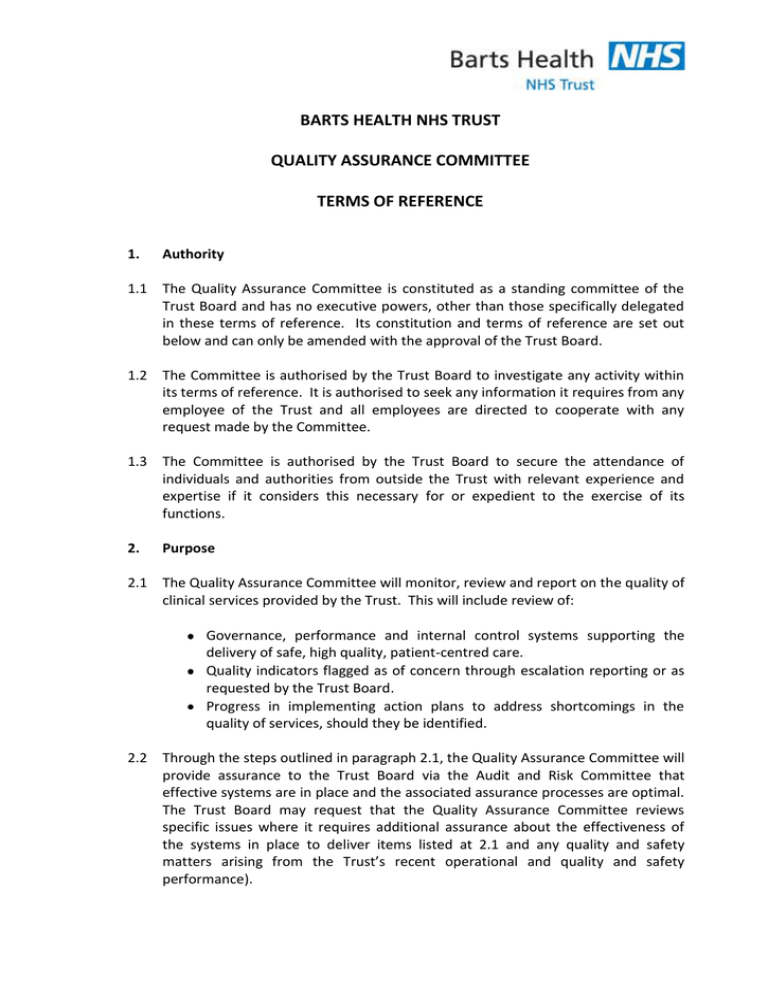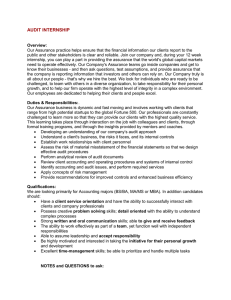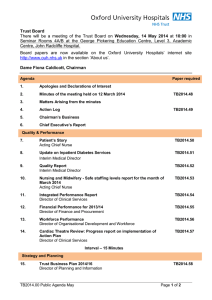BARTS HEALTH NHS TRUST QUALITY ASSURANCE COMMITTEE
advertisement

BARTS HEALTH NHS TRUST QUALITY ASSURANCE COMMITTEE TERMS OF REFERENCE 1. Authority 1.1 The Quality Assurance Committee is constituted as a standing committee of the Trust Board and has no executive powers, other than those specifically delegated in these terms of reference. Its constitution and terms of reference are set out below and can only be amended with the approval of the Trust Board. 1.2 The Committee is authorised by the Trust Board to investigate any activity within its terms of reference. It is authorised to seek any information it requires from any employee of the Trust and all employees are directed to cooperate with any request made by the Committee. 1.3 The Committee is authorised by the Trust Board to secure the attendance of individuals and authorities from outside the Trust with relevant experience and expertise if it considers this necessary for or expedient to the exercise of its functions. 2. Purpose 2.1 The Quality Assurance Committee will monitor, review and report on the quality of clinical services provided by the Trust. This will include review of: Governance, performance and internal control systems supporting the delivery of safe, high quality, patient-centred care. Quality indicators flagged as of concern through escalation reporting or as requested by the Trust Board. Progress in implementing action plans to address shortcomings in the quality of services, should they be identified. 2.2 Through the steps outlined in paragraph 2.1, the Quality Assurance Committee will provide assurance to the Trust Board via the Audit and Risk Committee that effective systems are in place and the associated assurance processes are optimal. The Trust Board may request that the Quality Assurance Committee reviews specific issues where it requires additional assurance about the effectiveness of the systems in place to deliver items listed at 2.1 and any quality and safety matters arising from the Trust’s recent operational and quality and safety performance). 2.3 The Quality Assurance Committee will also be responsible for reviewing, on behalf of the Trust Board, the proposed quality improvement priorities set in the annual plan and Quality Account. It will provide assurance to the Trust Board that improvement targets are based on achievable action plans to deliver them and support the development of the Trust’s quality strategy. 2.4 The Trust’s Audit and Risk Committee will retain overall responsibility for independently monitoring, reviewing and reporting to the Trust Board on all aspects of governance, risk management and internal control. Section 6 of these terms of reference sets out the reporting arrangements which will support the Audit and Risk Committee in discharging this responsibility. 3. Membership 3.1 The Committee shall be appointed by the Trust Board and be composed of: Three Non Executive Directors Chief Executive and/or Deputy Chief Executive Chief Medical Officer Chief Nursing Officer Chief Operating Officer Director of Workforce Development NHSI Improvement Director 3.2 One Non Executive Director will be appointed as the Chair of the Quality Assurance Committee and another will be appointed as the Vice Chair by the Trust Board. At least one member of the Quality Assurance Committee should preferably have relevant clinical experience or qualifications. One of the Non Executive Director members of the Quality Assurance Committee should also be a member of the Trust’s Audit and Risk Committee. 3.3 A quorum shall be three members, at least two of whom should be Non Executive members of the Trust Board. 3.4 Members should make every effort to attend all meetings of the Committee and will be required to provide an explanation to the Chair of the Committee if they fail to attend four meetings in a calendar year. If a member fails to attend more than four meetings in a calendar year the Chair of the Committee will consider the appropriate action to be taken, including the option of recommending to the Trust Board the removal of the member from the Committee. The Committee Secretary will monitor attendance by members and report this to the Chair of the Committee on a regular basis. 2 4. Attendance 4.1 Site Managing Directors and CAG Directors will be regularly invited to attend to support a rolling programme of exception reports. Other Non Executive Directors shall be welcome to attend and all members of the Trust Board will receive papers to be considered by the Committee. 4.2 The Committee may invite other Trust staff to attend its meetings as appropriate. In particular, where appropriate, the Committee will invite clinical teams to attend its meetings to provide assurance on key governance and risk issues. 4.3 The Director of Corporate Affairs and Trust Secretary will ensure that the Trust Office provides a Secretary to the Committee and appropriate administrative support to the Chair and committee members. This shall include agreement of the agenda with the Chair and attendees, collation of papers, taking the minutes and keeping a record of matters arising and issues to be carried forward and advising the Committee as appropriate. 5. Frequency of meetings 5.1 Meetings will generally be held on a monthly basis, with a minimum of six meetings a year. 6. Reporting 6.1 The Quality Assurance Committee will receive regular exception reports covering quality and safety issues escalated from the Quality and Safety Board and Risk Management Committee as part of an executive highlights report. The Committee will also receive regular exception reports from any subcommittee it establishes. 6.2 The approved minutes of the Quality Assurance Committee’s meetings will be circulated to all Trust Board members for information and an exception report presented to the next Trust Board meeting following each Committee meeting to draw to the attention of the Trust Board any issues that require disclosure to the full Board. 6.3 The Quality Assurance Committee will provide an annual report to the Audit and Risk Committee on the effectiveness of its work and its findings, including its review of relevant Board Assurance Framework entries and audit reports covering areas within its terms of reference. This will assist the Audit and Risk Committee in discharging its responsibility for providing assurance to the Trust Board in relation to all aspects of governance, risk management and internal control. In addition, a Quality Assurance Committee exception report will be included as a standing item on the Audit and Risk Committee agenda for information enabling the Chair of the Quality Assurance Committee to report back on the work of the Quality Assurance Committee. If there is any 3 perceived ambiguity regarding the relative roles of the Audit and Risk Committee and the Quality Assurance Committee in this respect, the committee chairs will liaise to agree a satisfactory approach. 7. Review 7.1 The Terms of Reference should be reviewed by the Committee and approved by the Trust Board at least every two years. 8. Duties Governance, internal control, performance and risk 8.1 To review the establishment and maintenance of an effective system of governance, performance and internal control in relation to clinical services, research and development, and education and training - in order to ensure the delivery of safe, high quality, patient-centred care. 8.2 To receive and review at each meeting those entries on the Trust’s Board Assurance Framework (BAF) which are to be overseen by the Quality Assurance Committee. (Agreement on the allocation of oversight of BAF risks between the Quality Assurance Committee and the Audit and Risk Committee will involve the chairs of the two committees and will be endorsed by the Trust Board.) The full BAF will be received by the Trust Board at least three times a year. 8.3 To advise the Trust Board on the appropriate quality and safety indicators and benchmarks for inclusion on the Trust Integrated Performance Framework and supporting data quality for these metrics. To support the development and ongoing monitoring of ward quality and safety dashboards. 8.4 At the request of the Trust Board (and in line with paragraph 2.1), the Quality Assurance Committee will include within its work plan regular reviews of operational performance where there is ongoing non-compliance with constitutional standards e.g. suspension of reporting against the 18 Weeks Referral to Treatment Time standard, 4-hour emergency care waiting time standards. This will include review of performance against recovery trajectories, supporting governance arrangements and action plans to return to compliance. Quality and safety reporting 8.5 The Trust’s Improvement Plan (Safe and Compassionate) has been developed with key stakeholders in response to: • The Care Quality Commission’s inspection visits in November 2014 (to Whipps Cross University Hospital), January 2015 (to The Royal London Hospital and Newham University Hospital) and February 2015 (to the 4 Margaret Centre at Whipps Cross) and the resulting inspection findings, Warning Notices and compliance actions. • 8.6 The NHS Trust Development Authority’s decision in March 2015, as a consequence of the Whipps Cross CQC report combined with Trustwide challenges in meeting national waiting time standards and the financial position, to place Barts Health NHS Trust in Special Measures. The Quality Assurance Committee will take a lead role in reviewing progress against this plan, through reporting from each site on its action plans (see paragraph 8.6) and through deep dive reports (aligning with the Executive Quality Improvement Board’s work plan). The Committee will, specifically: • • • • Through Improvement PMO reporting, track the implementation and delivery of the Barts Health Quality Improvement Plan against key milestones and outcomes, in relation to both cross-cutting and sitespecific aspects. Receive deep dive workstream PMO reports on a regular basis (aligning with the Executive Quality Improvement Board’s work plan). Consider key issues and risks and seek assurance that appropriate mitigations are in place, escalating to the Trust Board as necessary. Agree any additional resources required to secure the delivery of the Quality Improvement Plan. Review progress against the supporting communications and engagement plan. 8.7 The Committee will receive exception reports from each site on a rolling basis to update on progress in delivering its site Quality Improvement Plans; and other key actions taken to enhance clinical quality and safety, including in response to the findings of internal and external reviews, audits and inspections and trends in adverse events, complaints, claims and litigation. Managing Directors and senior members of the site leadership team will be invited to attend for these items. 8.8 The Committee will receive exception reports from Clinical Academic Groups (CAGs) on a rolling basis to update on steps to improve clinical standards on a Trust-wide basis. This will focus on monitoring KPIs and seek to include reviews of benchmarking, clinical audit and external assurances. 8.9 The Committee will receive Key Lines of Enquiry reports based on key quality and safety themes (identified and agreed by the Chair and lead executives as part of its work plan). These will include, but not be limited, to reports on infection control, safeguarding, mortality, maternity safety, complaints, etc. 8.10 To receive, at least annually, assurance reports in relation to: Research and development governance issues. 5 and education and training Work of the Health and Safety Committee. Clinical Audit (see paragraph below). Aggregated analyses of adverse events (including serious incidents), complaints, claims and litigation to identify common themes and trends and gain assurance that appropriate actions are being taken to address these. Patient experience (see paragraph below). Safeguarding children and adults. Key workforce issues impacting on quality and safety (including recruitment and retention, staff morale, equalities and inclusion). 8.11 To receive other related reporting on compliance with the Care Quality Commission’s Fundamental Standards, including any areas of current concern or focus. This will include involve work with executive groups established to support related improvement work (e.g. Executive Quality Improvement Board). 8.12 To receive and review the Quality Account and any other key non-financial governance submissions to national bodies and to make recommendations for sign off by the Trust Board. Audit and assurance 8.13 To review the annual Clinical Audit programme and receive assurances from Internal Audit (including an in-depth review on a three-yearly basis) regarding the effectiveness of the Trust’s clinical audit function. 8.14 To receive details of all national clinical audits where the Trust is identified as an outlier or a potential outlier. This should include but not be limited to mortality outlier alerts. 8.15 To review the Internal Audit operational plan and more detailed work programme and to make recommendations, subject to Audit and Risk Committee approval, on the clinical, research and development, and education and training aspects of the Internal Audit annual work plan. 8.16 To receive and review the findings of Internal and External Audit reports covering patient safety, quality and experience, research and development, and education and training, and to assure itself that the management of the Trust is implementing the agreed recommendations in a timely and effective way. 6 External Assurance 8.17 To receive all reports on the Trust produced by the Care Quality Commission and to seek assurance on the actions being taken to address recommendations and other issues identified. 8.18 To ensure that the Trust learns from national and local reviews and inspections and implements all necessary recommendations to improve the safety and quality of care. 8.19 To receive reports on significant concerns or adverse findings highlighted by external bodies in relation to clinical quality and safety and the actions being taken by management to address these (including, specifically, any external quality reviews commissioned by the Trust Board or conducted by third parties and due for publication, with potential stakeholder or media interest). 8.20 To monitor and review the systems and processes in place in the Trust in relation to Infection Control and to review progress against identified risks to reducing hospital acquired infections. 8.21 To ensure the work of the Committee is informed by and feeds into the work of the Trust’s Patient Experience Committee, including reviewing key messages from survey findings and ensuring a specific focus on improving patient experience and sharing best practice. Reviewed by the Quality Assurance Committee: 18 May 2016 Approved by Trust Board: 1 June 2016, and amended by Chair’s Action on 2 August 2016 7



